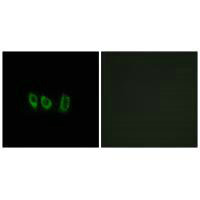
Immunofluorescence analysis of A549 cells, using CSTL1 antibody.
CSTL1 Antibody

CSB-PA030996
ApplicationsImmunoFluorescence, ELISA
Product group Antibodies
ReactivityHuman
TargetCSTL1
Overview
- SupplierCusabio
- Product NameCSTL1 Antibody
- Delivery Days Customer20
- ApplicationsImmunoFluorescence, ELISA
- CertificationResearch Use Only
- ClonalityPolyclonal
- ConjugateUnconjugated
- FormulationLiquid
- Gene ID128817
- Target nameCSTL1
- Target descriptioncystatin like 1
- Target synonymsCTES1; cystatin-like 1; dJ322G13.4; RCET11
- HostRabbit
- IsotypeIgG
- Protein IDQ9H114
- Protein NameCystatin-like 1
- Scientific DescriptionThe cystatin superfamily encompasses proteins that contain multiple cystatin-like sequences. Some of the members are active cysteine protease inhibitors, while others have lost or perhaps never acquired this inhibitory activity. There are three inhibitory families in the superfamily, including the type 1 cystatins (stefins), type 2 cystatins and the kininogens. The type 2 cystatin proteins are a class of cysteine proteinase inhibitors found in a variety of human fluids and secretions. The cystatin locus on chromosome 20 contains the majority of the type 2 cystatin genes and pseudogenes. This gene is located at the telomeric end of the cystatin locus and encodes a type 2 cystatin-like protein. The specific function of this protein has not been determined. Deloukas P., Nature 414:865-871(2001). The MGC Project Team; Genome Res. 14:2121-2127(2004). Xiang Y., Submitted (AUG-2004) to the EMBL/GenBank/DDBJ databases.
- ReactivityHuman
- Storage Instruction-20°C or -80°C
- UNSPSC12352203
